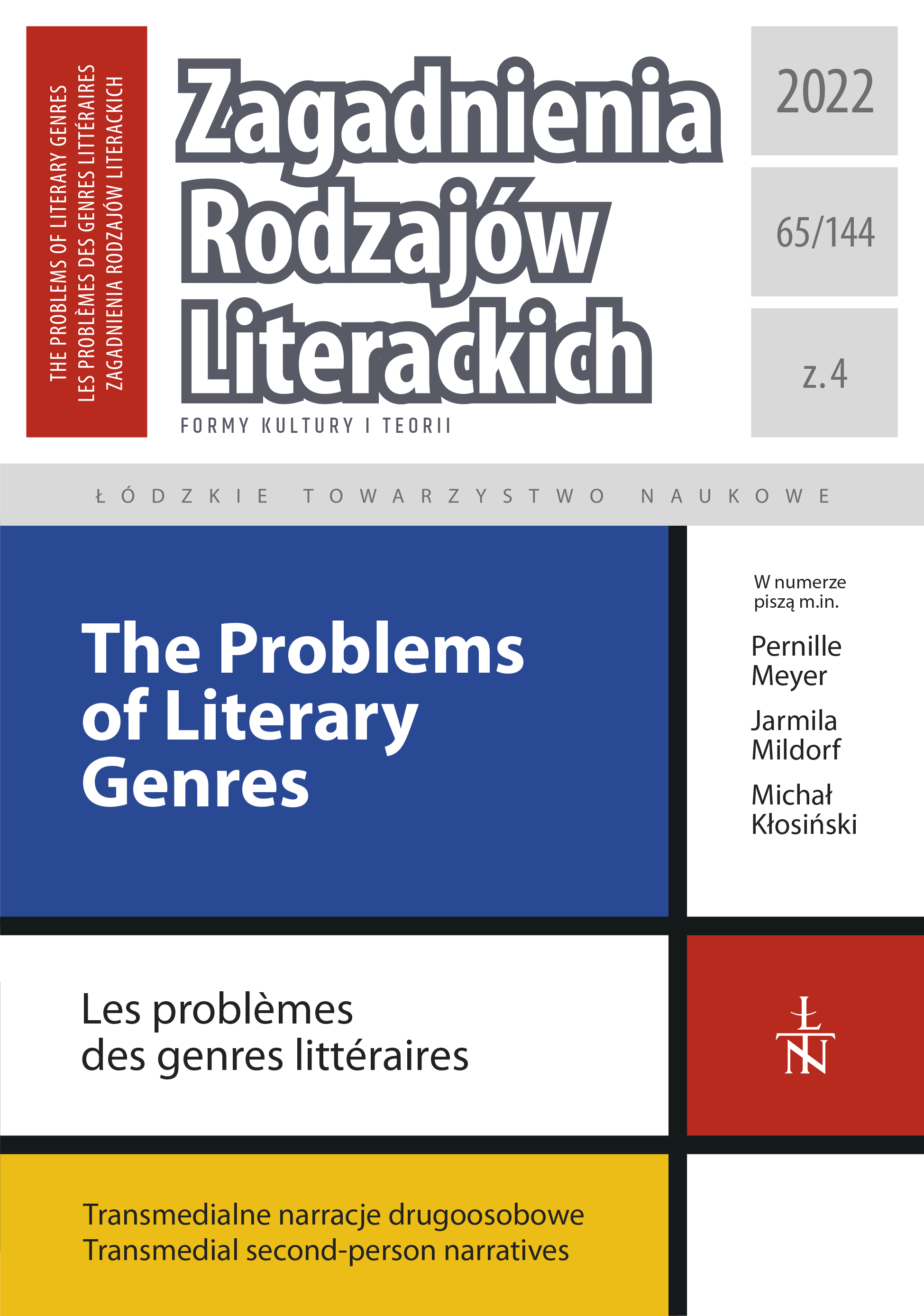Making Unstrange: Theory and Second-Person Fiction
DOI:
https://doi.org/10.26485/ZRL/2022/65.4/4Słowa kluczowe:
second-person fiction, psychoanalytic theory, literary semiotics, deictic theory, phenomenologyAbstrakt
Russian Formalism’s suggestion that artistic literature makes the familiar strange finds echoes in today’s theories of “unnatural narrative.” “Naturalization” of seemingly strange texts understands uncanny literary effects as based on qualities of “natural” spoken language. Sifting through structuralist, pre-structuralist, and psychoanalytic musings on second-person fiction or similar effects in interpersonal relations, all largely neglected as studies of second-person narrative were popularized among theorists and critics over the past thirty years, this article theorizes readers’ ‘realization’ or ‘virtualization’ of second-person address, narratorial apostrophe, and second-person protagonists. One reason we have no agreed-upon, comprehensive chart explaining second-person address’s variable effects on various readers (with an appreciative nod to Sandrine Sorlin), is not that no such chart is impossible — but simply that any such chart would be complex. Such projects might be nuanced by earlier thoughts focused on more general theories of psychology, phenomonology, and human exchanges. This requires more reflection on the fuctions, formulations, and effects of second-person narrative, but also more thinking about its affects.
Liczba pobrań
Bibliografia
Auroux Sylvain (1999), Les Langues du Monde, Bibliothèque pour la Science, Paris.
Barthes Roland (1977), Analyse structurale des récits [in:] Poétique du récit, ed. G. Genette, T. Todorov, Seuil, Paris.
Bennett Claire-Louise (2022), Checkout 19, Vintage, Dublin.
Benveniste Emile (1966), Problèmes de linguistique générale, Gallimard, Paris.
Booth Wayne C. (1961), The Rhetoric of Fiction, University Chicago Press, Chicago and London.
Bremond Claude (1973), Logique du récit, Seuil, Paris.
Buber Martin (1969), Je et Tu, trans. G. Bianquis, Editions Aubier, Paris.
Butor Michel (1957), La Modification, Minuit, Paris.
Butor Michel (1964), Essais sur le roman, Gallimard, Paris.
Calvino Italo (1979), Se una notte d’inverno un viaggiatore, Einaudi, Turin.
Chénetier Marc (1978), Ideas of Order at Delphi [in:] Facing Texts: Encounters Between Contemporary Writers and Critics, ed. H. Ziegler, Duke University Press, Durham, NC.
Coleridge Samuel Taylor (1816), Christabel: Kubla Khan, A Vision: The Pains of Sleep, John Murray, London.
Currie Mark (1998), Postmodern Narrative Theory, St. Martin’s Press, New York.
De Lauretis Theresa (ed.) (1986), Feminist Studies, Critical Studies, Indiana University Press, Bloomington.
Diengott Nilli (1987), The Mimetic Language Game and Two Typologies of Narrators, “Modern Fiction Studies” vol. 33(3).
Eco Umberto (1994), Six Walks in the Fictional Woods, Harvard University Press, Cambridge.
Fitzgerald F. Scott (1925), The Great Gatsby, Charles Scribner’s Sons, New York.
Fludernik Monika (1993), Second Person Fiction: Narrative You As Addressee And/Or Protagonist, “Arbeiten aus Anglistik und Amerikanistik” vol. 18.
Fludernik Monika (1994), A Test Case for Narratology, “Style” no. 28(3).
Fludernik Monika (1996), Towards a ‘Natural’ Narratology, Routledge, New York.
Francis Nelson (1967), Compositional Analysis of Present-Day American English, Brown University Press, Providence.
Fromm Erich (1968), L’art d’aimer, trans. J.-L. Laroche, F. Tcheng, Desclée de Brouwer, Paris.
Gast Volker, Deringer Lisa, Haas Florian, Rudolf Olga (2015), Impersonal uses of the second person singular: A pragmatic analysis of generalization and empathy effects, “Journal of Pragmatics” vol. 88.
Gault Pierre (1975), Les Désordres du récit dans “The Pedersen Kid”, “Delta” vol. 8.
Genette Gérard (1966), Figures II, Seuil, Paris.
Genette Gérard (2002), Figures V, Seuil, Paris.
Greimas Algirdas Julien (1983), Du Sens II, Seuil, Paris.
Hantzis Darlene (1988), “You Are About To Begin Reading”: The Nature and Function of Second Person Point of View in Narrative, Dissertation, Louisiana State University.
Hartshorne Charles, Weiss Paul, Burks A.W. (1958), The Collected Papers of Charles Sanders Peirce, Harvard University Press, Cambridge.
Hayakawa Samuel Ichiyé (1964), Language in Thought and Action, Harcourt Brace & Co., New York.
Herman David (1994), Textual ‘You’ and double deixis in Edna O’Brien’s A Pagan Place, “Style” no. 28(3).
Herman David (2002), Story Logic, University of Nebraska Press, Lincoln.
Hopkins Mary Francis, Perkins Leon (1981), Second-Person Point of View, “Critical Survey of Short Fiction” vol. 1, ed. F.N. Magill, Salem Press, Englewood Cliffs, New York.
Hyman Eric (2004), The Indefinite You, “English Studies” vol. 85.
Iser Wolfgang (1978), The Act of Reading: A Theory of Aesthetic Response, Johns Hopkins University Press, Baltimore.
Janson Horst Woldemar (1970), Histoire de l’art, Édition Cercle d’Art Paris, Paris.
Jefferson Ann (1980), The Nouveau Roman and the Poetics of Fiction, Cambridge University Press, Cambridge.
Kant Emmanuel (1985), Critique de la faculté de juger, trans. Alain Renaut, Gallimard, Paris.
Lacan Jacques (1966), Écrits, Seuil, Paris.
Laclau Ernesto, Mouffe Chantal (1985), Hegemony and Socialist Strategy: Towards a Radical Democratic Politics, Verso, London.
Malamud Sofia (2012), Impersonal indexicals: one, you, man and du, “Journal of Comparative Germanic Linguistics” vol. 15.
McHale Brian (1985), ’You Used to Know What These Words Mean’: Misreading Gravity’s Rainbow, “Language and Style: An International Journal” vol. 18(1).
McInerney James (1984), Bright Lights, Big City, Vintage, New York.
Melville Herman (1851), Moby-Dick, www.en.wikisource.org/wiki/Moby-Dick_(1851)_US_ edition [access: 14.12.2022].
Morrissette Bruce (1965), Narrative ‘You’ In Contemporary Fiction, “Comparative Literature Studies” vol. 2(1).
Oppenheim Lois (1980), Intentionality and Intersubjectivity: A Phenomenological Study of Butor’s La Modification, “French Forum Monographs”, 16, Lexington, Kentucky.
Peirce Charles (1955), Letters to Lady Welby, ed. I.C. Lieb, Whitlocks, New Haven.
Petitot Jean (2004), Morphologie et Esthétique, Maisonneuve & Larose, Paris.
Ricoeur Paul (1983), Temps et récit, Seuil, Paris.
Ricoeur Paul (1990), Soi-Même Comme un Autre, Seuil, Paris.
Sheriff John K. (1989), The Fate of Meaning: Charles Peirce, Structuralism, and Literature, Princeton University Press, Princeton.
Silverman Kaja (1996), The Threshold of the Visible World, Routledge, New York.
Simons Peter (2003), Modes of Reification, Conference paper, Reid Hall, Columbia Global Centers, Paris, 20 May.
Sonesson Göran (1998), The concept of text in cultural semiotics, “Sign Systems Studies” vol. 26.
Sorlin Sandrine (2022), The Stylistics of ‘You’: Second-Person Pronoun and Its Pragmatic Effects, Cambridge University Press, Cambridge.
Zunshine Lisa (2003), Theory of Mind and Experimental Representations of Fictional Consciousness, “Narrative” vol. 11(3).







